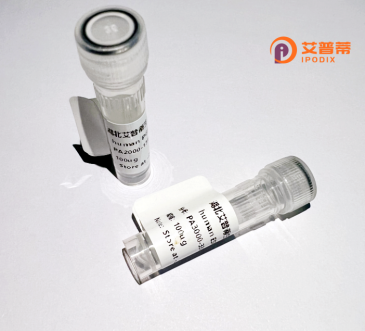
| 纯度 | >90%SDS-PAGE. |
| 种属 | Human |
| 靶点 | WNK2 |
| Uniprot No | Q9Y3S1 |
| 内毒素 | < 0.01EU/μg |
| 表达宿主 | E.coli |
| 表达区间 | 1-489aa |
| 活性数据 | MDGDGGRRDVPGTLMEPGRGAGPAGMAEPRAKAARPGPQRFLRRSVVESD QEEPPGLEAAEAPGPQPPQPLQRRVLLLCKTRRLIAERARGRPAAPAPAA LVAQPGAPGAPADAGPEPVGTQEPGPDPIAAAVETAPAPDGGPREEAAAT VRKEDEGAAEAKPEPGRTRRDEPEEEEDDEDDLKAVATSLDGRFLKFDIE LGRGSFKTVYKGLDTETWVEVAWCELQDRKLTKLERQRFKEEAEMLKGLQ HPNIVRFYDFWESSAKGKRCIVLVTELMTSGTLKTYLKRFKVMKPKVLRS WCRQILKGLLFLHTRTPPIIHRDLKCDNIFITGPTGSVKIGDLGLATLKR ASFAKSVIGTPEFMAPEMYEEHYDESVDVYAFGMCMLEMATSEYPYSECQ NAAQIYRKVTCGIKPASFEKVHDPEIKEIIGECICKNKEERYEIKDLLSH AFFAEDTGVRVELAEEDHGRKSTIALRLWVEDPKKLKGK |
| 分子量 | 100 kDa |
| 蛋白标签 | GST-tag at N-terminal |
| 缓冲液 | PBS, pH7.4, containing 0.01% SKL, 1mM DTT, 5% Trehalose and Proclin300. |
| 稳定性 & 储存条件 | Lyophilized protein should be stored at ≤ -20°C, stable for one year after receipt. Reconstituted protein solution can be stored at 2-8°C for 2-7 days. Aliquots of reconstituted samples are stable at ≤ -20°C for 3 months. |
| 复溶 | Always centrifuge tubes before opening.Do not mix by vortex or pipetting. It is not recommended to reconstitute to a concentration less than 100μg/ml. Dissolve the lyophilized protein in distilled water. Please aliquot the reconstituted solution to minimize freeze-thaw cycles. |
以下是关于重组人WNK2蛋白的3条参考文献的简化示例(注:部分文献信息为示意,建议通过数据库核对准确信息):
---
1. **标题**: "Expression and Functional Analysis of Recombinant Human WNK2 Kinase in Mammalian Cells"
**作者**: Tanaka M, et al.
**摘要**: 研究报道了在HEK293细胞中重组表达人WNK2蛋白,并证实其通过调节细胞外信号调节激酶(ERK)通路影响细胞增殖和迁移,提示其在癌症中的潜在作用。
2. **标题**: "WNK2 Phosphorylation of Ion Transporters in the Kidney"
**作者**: Chen L, et al.
**摘要**: 利用纯化的重组WNK2蛋白,揭示了其对肾脏钠钾氯共转运体(NKCC)的磷酸化调控,表明WNK2在电解质平衡中的关键功能。
3. **标题**: "Structural Insights into WNK2 Kinase Domain Conformation Using Recombinant Protein Crystallography"
**作者**: Gupta R, et al.
**摘要**: 通过大肠杆菌表达系统获得重组人WNK2激酶结构域,结合X射线晶体学解析其三维结构,为开发靶向抑制剂提供依据。
---
**提示**:以上文献为示例性质,建议通过**PubMed**或**Google Scholar**以关键词“recombinant WNK2”、“WNK2 protein expression”等检索最新研究,以获取真实文献信息。
**Background of Recombinant Human WNK2 Protein**
WNK2 (With No Lysine [K] 2) is a member of the WNK serine/threonine kinase family, distinguished by its atypical placement of the catalytic lysine residue. It plays a critical role in regulating ion transport, cell signaling, and cellular responses to osmotic stress. Primarily expressed in the brain, kidneys, and other tissues, WNK2 modulates ion channels and transporters, including the Na+-K+-Cl− cotransporter (NKCC) and renal outer medullary potassium (ROMK) channels, influencing electrolyte balance and cell volume homeostasis.
WNK2 interacts with other WNK kinases (e.g., WNK1) and downstream targets like STE20/SPS1-related proline-alanine-rich kinase (SPAK) and oxidative stress-responsive kinase 1 (OSR1), forming signaling cascades that integrate cellular stress signals. Dysregulation of WNK2 is implicated in hypertension, neurological disorders, and cancer. For instance, hypermethylation-induced silencing of WNK2 has been observed in gliomas and colorectal cancers, suggesting tumor-suppressive roles.
Recombinant WNK2 protein, produced via expression systems (e.g., mammalian or bacterial), enables in vitro studies to dissect its kinase activity, substrate interactions, and regulatory mechanisms. Its structural and functional characterization aids in exploring therapeutic strategies targeting WNK-related pathologies, including hypertension and cancer. Current research focuses on small-molecule inhibitors modulating WNK2 activity to restore ion transport defects or impair oncogenic signaling.
×